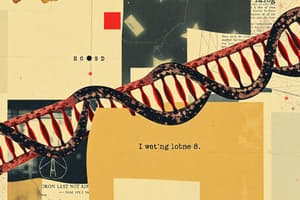Podcast
Questions and Answers
ما هي الوظيفة الرئيسية للحزم الكروموسومية؟
ما هي الوظيفة الرئيسية للحزم الكروموسومية؟
- لتنظيم وضغط الكروماتين المتجانس
- لتنظيم وضغط الكروماتين المتجانس وتفادي التشابك والتداخل مع العمليات الأخرى
- لتنظيم وضغط الكروماتين المتجانس وتمكين نسخ الرنا الرسول (correct)
- لتنظيم وضغط الكروماتين المتجانس والسماح بالوصول السهل إلى المادة الوراثية الأساسية
ما هي العمليات الحيوية التي ترتبط بالحزم الكروموسومية؟
ما هي العمليات الحيوية التي ترتبط بالحزم الكروموسومية؟
- الطبع الوراثي والوراثة الأبوية، وتنظيم التعبير الجيني
- الانقسام المنصف، وتنظيم التعبير الجيني، وتعديل الحمض النووي
- الطبع الوراثي والوراثة الأبوية، والانقسام المنصف
- كل ما سبق (correct)
كيف تساهم الحزم الكروموسومية في تنظيم التعبير الجيني؟
كيف تساهم الحزم الكروموسومية في تنظيم التعبير الجيني؟
- من خلال ضغط الكروماتين المتجانس وتسهيل النسخ
- من خلال تنظيم ارتباط عوامل النسخ والبروتينات التنظيمية الأخرى
- كل ما سبق (correct)
- من خلال تعديل الميثلة في الحمض النووي
ما هي أهمية دراسة بنية وظائف الحزم الكروموسومية؟
ما هي أهمية دراسة بنية وظائف الحزم الكروموسومية؟
ما هي الوظيفة الرئيسية للحزم الكروموسومية في ضغط الكروماتين المتجانس؟
ما هي الوظيفة الرئيسية للحزم الكروموسومية في ضغط الكروماتين المتجانس؟
ما هو الهدف الرئيسي من عملية الانقسام المنصف (الميوزي) في الخلايا؟
ما هو الهدف الرئيسي من عملية الانقسام المنصف (الميوزي) في الخلايا؟
ما هي الأهمية الرئيسية لفهم بنية وظائف الحزم الكروموسومية؟
ما هي الأهمية الرئيسية لفهم بنية وظائف الحزم الكروموسومية؟
ما هي الخطوة الأولى في عملية الانقسام المنصف (الميوزي)؟
ما هي الخطوة الأولى في عملية الانقسام المنصف (الميوزي)؟
ما هو أحد الأمراض الوراثية الناتجة عن خلل في بنية الحزم الكروموسومية؟
ما هو أحد الأمراض الوراثية الناتجة عن خلل في بنية الحزم الكروموسومية؟
ما هو الهدف الرئيسي من تكرار وضغط الحزم الكروموسومية خلال دورة الخلية؟
ما هو الهدف الرئيسي من تكرار وضغط الحزم الكروموسومية خلال دورة الخلية؟
Flashcards are hidden until you start studying
Study Notes
Cremosomes
Cremosomes, also known as chromatin threads or chromocenters, are condensed masses of chromatin fibers located within the nucleus of animal cells. These structures play crucial roles in various cellular processes, including DNA replication, transcription, and gene expression. In addition, cremosomes have been associated with multiple biological phenomena such as genomic imprinting, meiosis, DNA methylation, and heterochromatin compaction.
Historical Background
Cremosomes were first documented by Raphael Dubois in the 1840s while studying sea urchin embryos under microscopes. However, their significance was not fully understood until the 1940s when researchers began to recognize them as chromatin threads. The term "cremosome" itself was coined in 1958 by E. C. Blumenthal during his research on the organization of euchromatin within nucleoli.
Structure and Composition
The structure of cremosomes varies between species. In many animal cell lines, such as HeLa cells derived from human cervical cancer, cremosomes appear as brightly staining, dense foci inside the interphase nucleus. These structures are composed primarily of proteins, including histones H1, H2A, H2B, and H3, which serve as structural components of chromatin fibers and regulate their organization. Additionally, other non-histone proteins involved in DNA packaging and repair, transcriptional regulation, and DNA replication contribute to the formation and function of cremosomes.
Functions and Processes
The primary role of cremosomes is to organize and compact euchromatin, allowing efficient accessibility to the underlying genetic material during various cellular processes. This compact organization enables chromatin to be easily transcribed into messenger RNA while preventing it from becoming entangled or interfering with other processes.
Cremosomes have been associated with several biological phenomena, including genomic imprinting, where the expression of certain genes is regulated by epigenetic marks and parent-of-origin effects. They also play a critical role in meiosis, where they are involved in the condensation and organization of chromatin during the prophase I stage.
Furthermore, cremosomes are implicated in the regulation of DNA methylation, which is a process that modifies gene expression by adding a methyl group to the cytosine base of DNA. This modification can influence the binding of transcription factors and other regulatory proteins, ultimately affecting gene expression levels.
Cremosomes are also involved in the compaction of heterochromatin, which is a region of chromatin that is highly compacted and transcriptionally inactive. This compaction serves to facilitate the transition between interphase and mitosis, as well as to maintain genomic stability.
Future Directions
Understanding the structure and functions of cremosomes holds significant potential for advancing our knowledge in various fields, such as genetics, molecular biology, and cell biology. Future research should focus on uncovering the molecular mechanisms underlying cremosome formation and function, as well as their role in maintaining genomic stability and regulating gene expression.
In summary, cremosomes are essential structures within the nucleus of animal cells that play crucial roles in organizing and compacting chromatin fibers, regulating DNA replication, transcription, and gene expression, and are associated with multiple biological phenomena. Further investigations into their molecular composition and mechanisms will pave the way for a deeper understanding of the complex processes that govern cellular function and development.
Studying That Suits You
Use AI to generate personalized quizzes and flashcards to suit your learning preferences.




